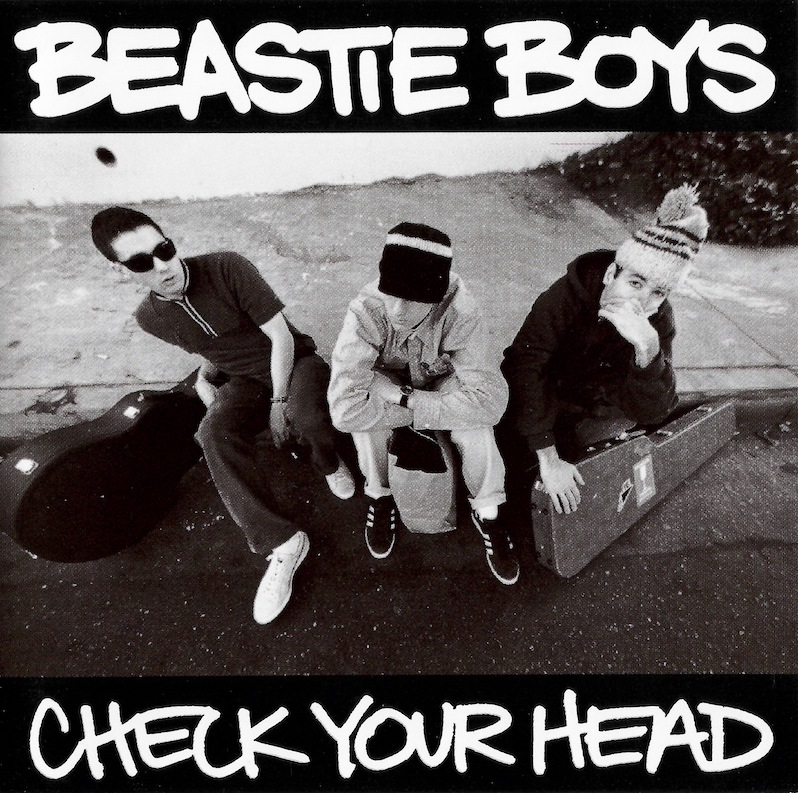On Check Your Head, The Beastie Boys pulled off an incredible reinvention

The Beasties were burnt. After the meteoric rise of their culture breaker of a non-stereotype rap group and origin story, Licensed to Ill, the trio fled their home base of New York City and label Def Jam for the greener shores of Los Angeles and Capitol Records to have artistic control in the West Coast sun on 1989’s Paul’s Boutique, an artistic breakthrough that was a commercial flop at the time. Once Mike D., MCA, and Ad-Rock hit the early ’90s, they were beaten and nearly forgotten.
So much so that Capitol Records didn’t even communicate with them for a couple of years.
The Boys were no longer hot. So they smoked weed, played basketball, built a skateboard ramp, and ultimately familiarized themselves with their instruments once again at G-Son Studios in Atwater Village. Adam Horovitz’s first outfit, The Young and the Useless, opened for Bad Brains at CBGB’s in 1982. And it became that fire, that inspiration, a punk ethos, that the group would revisit at their lowest point.
Between the bong hits, three-pointers, and skinned knees, The Beastie Boys found themselves again. The before hip-hop version was where they earned that initial street cred. As Ad-Rock puts it in the documentary made by Apple TV+ in the Beastie Boys Story, “Five years earlier, we’re at Madison Square Garden. Now we’re playing clubs. You’d think we’d be bummed out about it. But actually, falling off can be fun.”
Check Your Head, released in April 1992 was their third album, and at the time of its release to me, it sounded kinda mellow in context with the previous two releases. But 30 years later, it’s smoking. They are rapping their asses off like never before, speaking with that freedom, vibing with a different type of bravado, letting cats know they got it and a whole other thing too. Clocking in just under an hour, the collection of 20 songs resembles a Spotify playlist or mixtape.
It sounds like three bands hijacked your backyard BBQ on the 4th of July: One street-punk outfit ready to fuck shit up and burn this mother down (“Gratitude,” “Time for Livin'”), one white-boy hip-hop group rapping for their vegan dinner and a six-pack (“So What’cha Want,” “Jimmy James”), and then an impromptu funk trio who are really nice with the instrumentals and ’70s blaxploitation musical cues but would most definitely snatch your crate of records when nobody was looking (“Pow,” “In 3’s”).
The record not only reset the boundaries and parameters of what a Beastie Boys album would consist of, but it’d also become a ridiculously influential piece of art for the rest of the decade. By returning to playing live instruments, something they would continue in the future, they set the vibe for other flannel-clad, suburban (white) groups. Who’d try and try, but just could not fit into that Beastie space of coolness.
It was such a hard pivot, Entertainment Weekly in 1992 gave the record a D. Not that Entertainment Weekly had a firm grip on suburban youth culture at the time or made research runs to examine that culture adopting hip-hop as their soundtrack along with Sonic Youth. Did EW attend Spring Fling at UMASS Amherst during that time period where Fishbone, opening act for The Beasties, started several mosh pits? I’m sure they were one of those platforms likely to use the term “alt-rock,” a shortened term that gives no insight to what it’s paraphrasing.
When Angelo Moore of Fishbone jumped off the stage and dove into one of several mosh pits on that bill, he wasn’t concerned about which bin his record was being filed under. As he injured his ankle and limped back on stage to finish his set so the Beasties could feed their masses, Moore knew exactly how much the culture had flipped and was good with it. (EW can file that under awesome.)
Listen, most rap-rock combo bands in the ’90s sucked. They got no play in the hood, at basement parties, or under streetlights shining on park benches in the dead heat of summer. Those wanna-be-down copycats lacked one thing: Love of culture.
Beasties had incubation schooling, time with elders of the craft around them from the start. Run-DMC, LL Cool J, and most notably Public Enemy, second-wave Hip-Hop luminaries, but more importantly, Black Men from New York City and the culture-making boroughs, living in the race-riot era of New York City pre-Guliani mind you, forced to subscribe by a quality-control code. Every day. If the Beasties were, let’s say a fake or ‘fugazi’, those Brothers would have kicked those cats to the curb from jump.
Released after Nirvana’s Nevermind, Pearl Jam’s Ten, and Soundgarden’s Badmotorfinger—Check Your Head possessed all that hip-hop legacy with just as much grunge-meets-hardcore energy. It completed the band’s DNA.
***
Buy this album at Turntable Lab
Support our Site—Subscribe to Our Patreon: Become one of our monthly patrons and help support an independent media resource while gaining access to exclusive content, shirts, playlists, mixtapes and more.
John-Paul Shiver has been contributing to Treble since 2018. His work as an experienced music journalist and pop culture commentator has appeared in The Wire, 48 Hills, Resident Advisor, SF Weekly, Bandcamp Daily, PulpLab, AFROPUNK and Drowned In Sound.

